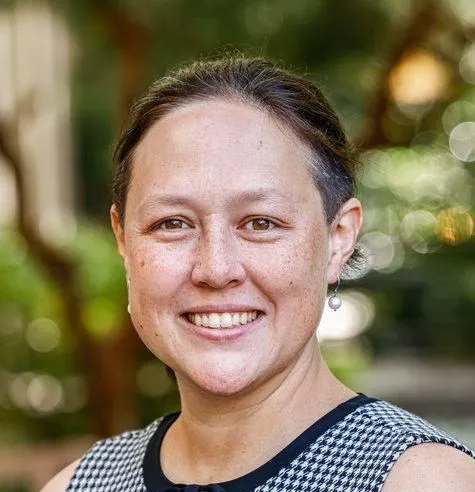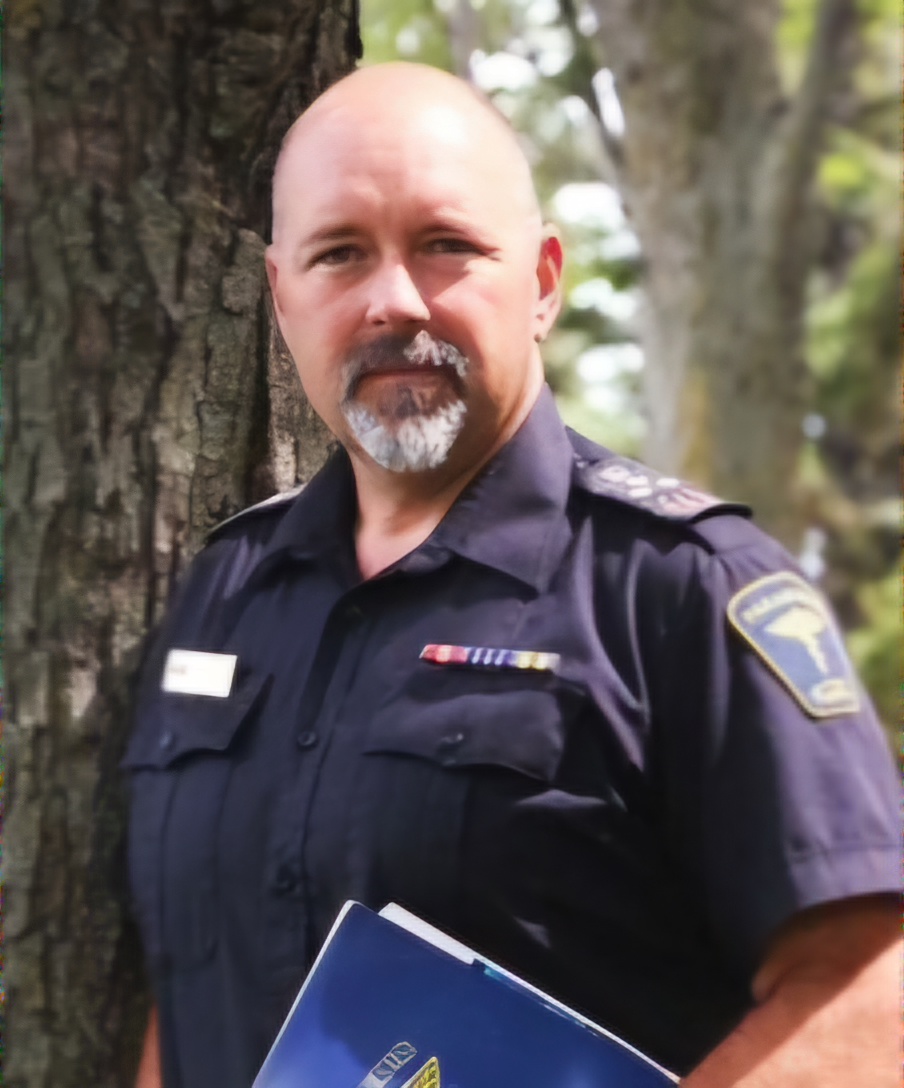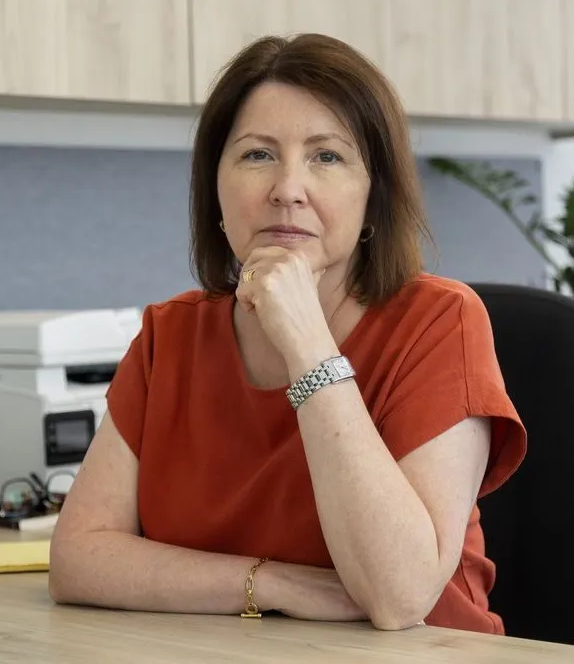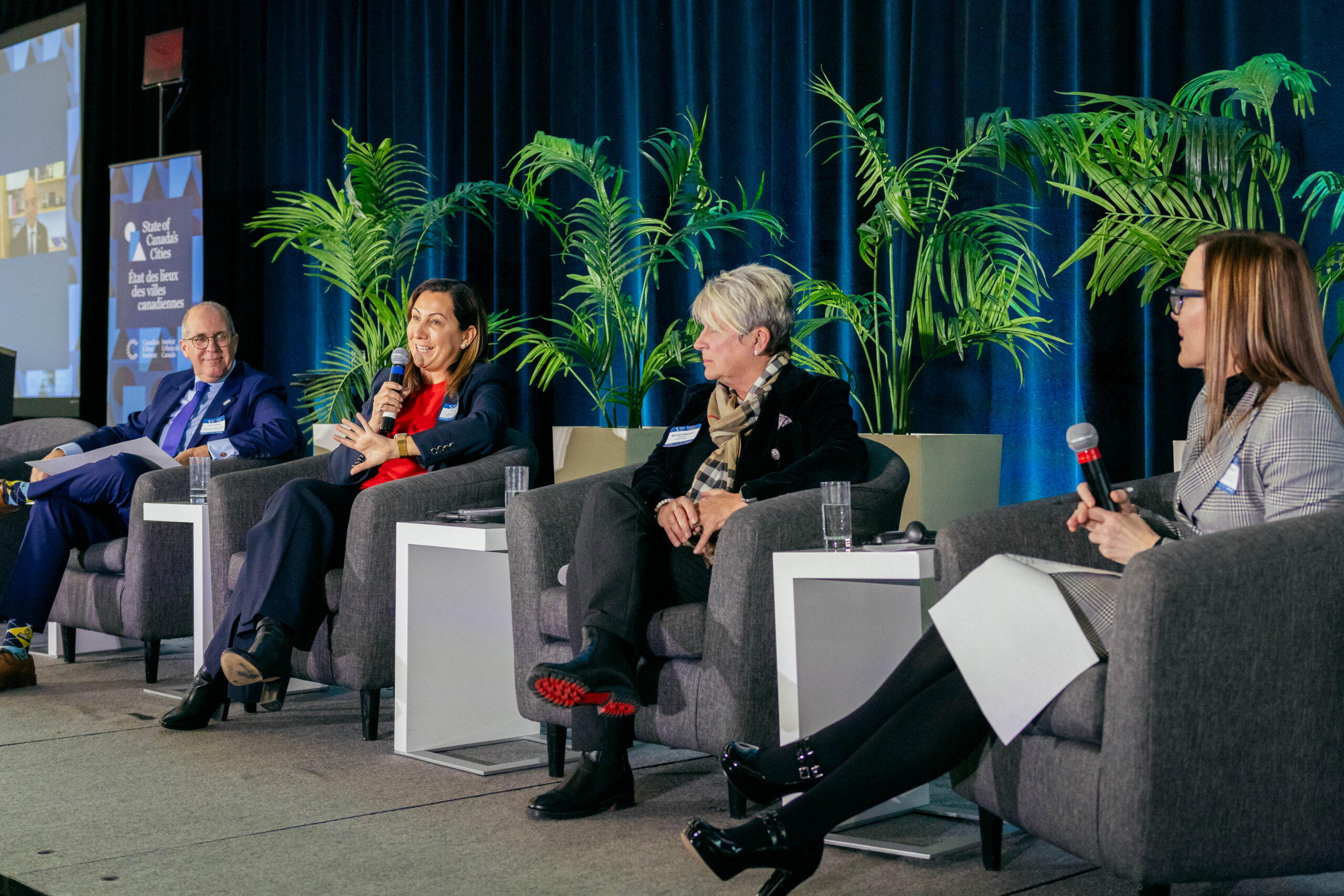Featured Guests
You’ll find this guest among our growing roll of Urban Champions.
-

Tracy Hadden Loh
Fellow, Brookings Metro, Anne T. and Robert M. Bass Center for Transformative Placemaking
-

Lori Shannon
Community Paramedic, County of Renfrew
-

Michael Nolan
Chief, Paramedic Services Director, Emergency Services, County of Renfrew
-

Paul Stam
Sergeant, Ottawa Police Services
-

Pam Tobin
Chief Executive Officer, CMHCA, Thames Valley Addiction and Mental Health Services
Building on the challenges set out in the morning sessions, what are the tangible approaches being taken in local communities to strengthen social, economic and environmental resilience, and make our cities more productive and equitable. What must each sector do to contribute to the new urban agenda?
Janet Talbot Good afternoon, everyone, and thank you for joining us. We have 45 minutes together today. I think it’ll go quite quickly. We’ll be discussing Ground-truthing: Strategies for Success. One of the things I’ve heard quite a bit today and leading up to today is a sense of wanting to leave with some optimism and some takeaways that we can feel good about. And as we are responsible for talking about success today, I hope we deliver that for you. And that’s certainly our intention. As I said, or if I didn’t say my name is Jane Talbot, then I’m the president and CEO of the downtown Vancouver BIA. I’ll be your moderator today. And joining me as panelists, we have Maureen Adamson, President of Fleming College, Peterborough, Ana Bailão, head of affordable housing at Dream Unlimited, Meric Gertler, joining us online, President of the University of Toronto, and Patrick Sullivan, President and CEO of the Halifax Chamber of Commerce and past chair of the Canadian Global Cities Council. Thank you all for joining us. And Meric, thanks for joining us online. It’s a pleasure to be here. Okay. So, like I said, I expect this time to go really quickly. I have one or two prepared questions for each the panelists. And given the brilliant minds that we have in the in the room today, I’m hoping that we get questions from you. We get them early and I will do my best to to to have our panelists answer all of them. So please weigh in. And with that, we’ll get started. Ana, I have to start with you. So today we’ve heard so much about housing, affordable housing, access to housing, the role that every sector has in or should have in securing housing. And my question to you is really about the private sector. I know you have extensive experience in both the public and the private sector. But today, let’s drill down on on, on private. First of all, what is the role the private sector plays in city building?
Ana Bailão So I think you’re right. I’ve seen it from both sides. 5 minutes in the private sector because I’ve just left a 12 year career in politics. So I think I’m in that moment that I can be really candid about politics and really candid about the private sector. And I think they have a big, big role to play in city building. When when I was looking for my next career where I was going to go. One of the questions I needed to answer myself is. I want to be in some place that is going to lead city building. And I think the private sector you have a decision to make. You can lead or you can just allow to be led by the policies that the governments create. And when I joined a private company like Dream, it was important for me to join somebody that it was going to lead. It was important to have somebody that had as a goal, for example, to have all its entire portfolio as a net zero by 2035, to have 20% of social procurement in everything that they do from their office to their industrial to their to their residential. It was important to have to be in a company that is developing affordable housing and even creating capacity with the nonprofit sector in many projects that that we have, for example, here in Ottawa, the company and I consider this a success story, is working with Multi-Faith. I was just talking with Lorraine on on a project on federal lands that is going to have 41% of affordable housing and the the nonprofit is going to own the units. We’re going to be in a partnership that they’re going to manage the building and we’re creating capacity through the private sector. If this is not city building, I don’t know what’s not. And that’s exactly what, for example, Romi was talking about in the morning, that we need to create capacity, and that’s how we create capacities by bringing governments, bringing the private sector and the nonprofit sector to create capacity. So I think that we have a really important role in city building, especially when, you know, you have projects like in Toronto that we’re doing the key key side project, again, partnerships with governments, with nonprofits and and the the private sector that can deliver social infrastructure as well, the affordable housing that we need. So I think the private sector has a big a big role to play.
Janet Talbot Thank you. So you’ve talked about at least two success stories there. What major barrier did you have to get through to achieve that success?
Ana Bailão I think and I speak this from the experience that I had at the city as well, leading housing as well. I think these silos that we still see and the lack of collaboration is significant still to produce the affordable housing, the scale that we need and the speed that we need. So I think that what we need to really tackle this issue is scale, speed, collaboration and partnership. And when you don’t have that, you’re really it’s a it’s a big challenge when governments are at odds with each other, when we even have a hard time defining what affordable housing is, because each government has always its own definition. All these things make it harder to deliver at the speed and at the scale that we need to deliver. And it doesn’t matter if it’s the government delivering, the private sector delivering or the nonprofit, there’s issues that are so common for everybody that becomes an obstacle.
Janet Talbot We’ll be returning to the issue of scale in a couple of minutes. We were just talking about it at my table, so I’m glad you brought that up. My next question is for Mark and Maureen. It’s a two part question. And it’s around how universities contribute to urban productivity inequity. Marek Part one of the question will go to you. And Maureen, Part two of the question will go to you. The question is what role do colleges and universities play in helping local communities strengthen social, economic and investor environmental resiliency? And. For you, Maureen. What are you experiencing your day to day that will help answer what’s working here? What isn’t working? What successes do we have? And and maybe what’s next? So, Meric, over to you. Would you like me to repeat the first part of that?
Meric Gertler No, I think I got it. I think I got it. Well, thank you, Jane. First of all, sorry. I can’t be in Ottawa to join you all in person. That’s generally my preference. But my calendar this week just wouldn’t allow it, so I’m glad to be able to participate by Zoom. It’s a topic I could spend the next few hours talking about, but for now, let me just focus on two ways in which universities help their communities get stronger socially, economically, environmentally. First of all, the role we play as gateways for opportunity and inclusion, and secondly, the role we play as leaders in tackling the climate crisis. So on that first topic, universities in Canada actually occupy a really unique and unusual space. Most Canadians don’t realize this. On the one hand, we’re very well respected and very well ranked globally, and at the same time we are uncommonly accessible and inclusive as post-secondary institutions. Just to use my own institution as an example. You know, the next year you have to be ranked number 21 in the world amongst four or 5000 universities, ranked by times higher education or 10th in the world amongst public universities and for medical research. The journal Nature ranked U of t third in the world. So, you know, we’re very, very highly regarded. And yet and yet we have almost 100,000 students. We have 97,000 students across three campuses. We graduate as many students in one year as all the Tiger Ivy League combined. More than half of our domestic undergrads come from low and middle income households. More than two thirds self-identify as racialized. At two of our three campuses in Mississauga and Scarborough are in suburban locations where Canadians have have settled in large numbers as the new Canadians of immigrants coming into this country. So no other post-secondary system in the world combines these two attributes of excellence and inclusion, as well as the Canadian system does. And that’s something I don’t think we appreciate as well as we ought to. Of course, we also welcome students from around the world. Something like 30% of our enrollment is international, and you’d be interested to know about half of our international students remain in Canada after they graduate. So it really is a net gain of talent for the country. I would argue that our success in educating these young Canadians and future Canadians is going to have massive consequences for the success of metropolitan areas like the GTA and other similar urban regions across the country. Of course, we also have to house these students somehow, and I know housing has been very much top of mind today in the recession and there’s been a lot of attention from media on this issue in recent months, particularly, though not exclusively devoted to international students. And indeed, the new report from the Canadian Urban Institute, in partnership with our School of Cities, puts the spotlight on the housing challenge, as well as making some interesting suggestions regarding the roles that universities can potentially play in helping to find solutions. But let me emphasize a crucial point. Universities in most provincial jurisdictions, including Ontario, currently receive zero. Let me repeat zero assistance from any level of government for the provision of housing for students, despite the fact that we have guaranteed demand from our students. In many cases, we have land we can build on. We have the inclination because there is such a sense of urgency. We know how pressing it is to provide affordable housing for our students, and we’re getting a lot of pressure from our neighbors to do so. So, you know, I’ve got a few ideas about what we could do to address that issue. But maybe I’ll save that for a little bit later in the discussion. And move just to the second point about the climate crisis and the role that universities are playing. I mean, COP 28 started this week in Dubai, underscores the urgency of this issue. We’ve got no time to waste, but it also reminds us that we can’t wait for world leaders to figure this out. Local action is going to be crucial. And universities role, I think, is both important but largely overlooked. It’s potentially huge again, to use the U of T as an example where the third largest emitter of greenhouse gas in our public sector, it turns out, and we’re neck and neck with some major private sector emitters like automotive assembly plants. The Honda plant in Alliston, about the same emission has as U of T. This is perhaps not surprising because we own 300 hectares of land, about 260 buildings. So, you know, the carbon footprint is going to be considerable. The good news is we have a plan to reduce our emissions really quickly. And I could talk a little bit more about that when we get to discussion. But my point is that this is a huge contribution that we have the potential to make and it’s being under under leverage at this point.
Janet Talbot Thank you, Meric, you’ve set Maureen well up for a for a response to that. First of all, Maureen, would you like to to add anything or weigh in or are you ready to just dive into where we’re seeing success?
Maureen Adamson Oh, I think it’s really important to differentiate a college, which is a community college versus a place like University of Toronto, which is where I got my MBA and Meric desperately trying to finish my Ph.D. as we speak, because, as you’ll recall, community colleges were set up for the very purpose of responding to the second Industrial Revolution. There was mass consumption of education, and it’s very much an access kind of agenda. And so I think, you know, for colleges to truly anybody can run a college, I can tell you that for free, but not anybody can play the role of being a convener of disruptive conversations in a community as a president of a college in a place like Peterborough. And I’ve lived my whole adult life working and living in Toronto. You have influence. And so it’s a big opportunity to use that influence with the mayor, with the local opinion leaders. And I think there’s a whole host of things that colleges can be doing in their regions to convene disruptive discussions. I know I’ve done that at Fleming. We had a we had the had actually come and speak at a group of local opinion leaders as well as experts. And best part of it was Mary Rowe was our keynote as well. And it really got people thinking there’s still a buzz in the air. The other thing I think that community colleges can do, because they’re agile and particularly outside of Toronto, we have a lot of land. I am so not used to looking across tons and tons of acres of asphalt that you never see in Toronto anymore. And how are we capitalizing on that? And one of the things that we’re doing is we’ve got obviously we’ve got urban strategies helping us and we’re developing a whole campus that’s contiguous with the college, but we’ll provide local housing, housing that’s suitable for a place like Peterborough. It will provide seniors housing, and we’ll also provide a parcel of land where we can have complex continuing care, which we don’t have. In a region like that. There is no Bridgepoint, there is no West Park. So I think community colleges not only need to talk about it, but ante up and ante up some of their assets where the private sector plays such a critical role to come in to that. And then the other thing I would say is having been a deputy minister in my life, we need to do a better job as leaders to talk to the bureaucracy and help them understand how it really works, because largely they are in their Queen’s Park castle. They only know what they’re told. Politicians only know what they’re asked many times at a barbecue. And we need to do get these folks to create the right due diligence for the politicians to make the decisions. And I think, you know, as a community college leader, we’re very close to that and there’s no reason we shouldn’t be doing it.
Janet Talbot Thank you. Patrick, you’re up next. So we continue to hear a lot about the need for all levels of government to come together to solve pervasive problems affecting our downtowns and our urban centers. Let’s talk about a success story where all levels of government came together to effectively address a significant problem in an urban center. What would you say was the most significant barrier that needed to be addressed? And why ultimately was the partnership successful?
Patrick Sullivan Well, thank you, Jane. Hello, everyone. I think the example I’ll I’ll come back to and of course, we don’t want to remember the bad days of the pandemic, but it was a it was a great opportunity for communication and for partnership. So on March 16th, days after the World Health Organization declared a pandemic, we came together with various levels of government. So we managed to reach out to two or three deputy ministers. We included the mayor of the city of Halifax, the CEO. We also invited organizations across the province of Nova Scotia to begin to talk. We ended up talking quite frequently, in fact, during the early days of the pandemic. We met three times a week for an hour at a time on Zoom. It was the ultimate, I suppose, in communication. It was policy making in real time as the provincial government would develop a policy to satisfy the needs of small businesses. Given the given the state of the pandemic or the state of the the situation, I suppose what we what we saw were policymakers coming to us presenting an option at 12:00, providing comment. And by 1235 they had revised that policy to better reflect the needs of the community that we were representing. And that community included over 200 organizations across the province of Nova Scotia. It included not for profits. It included business organizations and government organizations. So it was a wonderful two year honeymoon, I suppose. The bright spot during the pandemic where we were communicating frequently and often, and my dream was that that kind of communication would continue post-pandemic. But sadly, many of us have kind of moved back to perhaps the silos that Mary mentioned, you know, and we’re back in those silos. But it was a wonderful opportunity. And I, I like to bring it up because it was so successful that we’d like to reach out to those organizations again to bring them back, as I think everyone on the panel has said, and many panels today, that partnership and that communication is what’s going to get us through the next ten, 20, 30 years.
Janet Talbot Yeah, I think we all remember. And where there is anything to be pleased by. During the pandemic, it was the speed with which our levels of government came together and there was a collective spirit of problem solving for the greater good. And as you say, we’ve lost that a bit. We’ve sort of gotten back to our normal path. What do we need to do to get it back without a crisis, without a pandemic?
Patrick Sullivan Well, I think we’ve got lots of opportunities right now. I mean, if we look at a housing crisis. I mean, it’s not a pandemic, but there are clearly people suffering. We need to make change and we need to make change in a hurry. We know we need the private sector. We know we need government at all levels. We need our educational institutions as well. If we could come together, I think we could do things more quickly. But right now, you know, and I think Zeta’s left. But, you know, of course, I’m not going to promote the urban rural divide that she was so much against. But, you know, we are seeing various levels of government not talking to other levels of government. I mean, we’re here today talking about cities. I don’t think there’s anyone from my provincial government that’s here. We certainly have municipal representation here. But we need to get first provinces and municipalities talking. And, of course, the federal government needs to be part of that communication as well.
Ana Bailão Can I say something? I think maybe sometimes we need to look instead of looking at things as a crisis, maybe as an opportunity, as having the conversation with somebody last evening and they’re saying, why are we looking at this as a housing opportunity? And just between us here, just look at how the nature of the downtown is changing. Is there an opportunity there to change, to respond to the needs of how people are leaving that are academic institutions? We could be leaders in innovation in an industry that doesn’t have a lot of innovation, real estate housing doesn’t have a lot of innovation. We could be leaders in that because there’s the growth that we experience. Very few cities are experiencing this growth that we have right now. So can we actually turn this crisis into an opportunity? How can we train more people, have the speed, have the skills, respond to the changing nature of of our cities, of urban centers, and actually be leaders in models? I, I always like to look at the opportunities here for me. I always try to look for the positive. And I think we need to start looking at this in a different way to be more positive.
Janet Talbot America, I see you nodding. Would you like to weigh in?
Meric Gertler Sure. Absolutely. Yeah. I love Ana’s phrasing and reframing. I agree. I mean, as I was saying in my opening comments, you know, when it comes to an issue like student housing and Marine, I think you and I are very much on the same page. Universities actually are very, very keen as colleges are, to work with private sector players and work with government to to actually really move the needle. But we as I said, we’ve got land even in downtown Toronto, believe it or not, Maureen, and and on our Mississauga and Scarborough campus as well, we’ve got guaranteed demand. A lot of private sector investors are actually quite attracted to work with us. And we are partnering with a number of different developers on joint projects that we’re working out. The model as we go, we’re able to tap their expertise in terms of construction and project management. We can tap into their capital as well. And, you know, we are learning along the way and innovating. And I think there’s, you know, we’ve only just scratched the surface here, but I, I completely agree with the spirit of of Canada’s intervention as well as BRICS observation.
Janet Talbot Thank you. Keeping with the spirit of optimism. I’m going to bring up something that one of our previous panelists said. And he said, I remain optimistic because we live in an unprecedented moment of creativity. I have a question, but I see you all nodding. So, Ana, I’m just going to hand that over to you and get your thoughts on that.
Ana Bailão I think it’s true. And I think every sector can be creative about things. I know that, for example, our team at DREAM has been pushing the boundaries on creativity. We worked with CMHC on a program that is called MRI, Select where we get financing, but it’s attached to affordable housing, to sustainability and accessibility. That is a program that is now available from coast to coast to coast. And we’ve had buildings that we increased affordable housing and we reduced GSA from 30%. We have office towers in downtown Toronto that is being in partnership with the Canadian Infrastructure Bank. 19 of those buildings that we have in downtown Toronto are going to be reducing their GHG because of the partnerships that and we were the first ones in the country to receive that financing. So these are innovative solutions that we need to tackle. Again, the challenges of the day, right? The the climate changes that we’re dealing with, the affordability issues that we’re dealing with. The partnerships that I talked about, how can we leverage each other’s participation in this ecosystem? I think those are really important innovative models to create, to respond to the challenges like housing as well.
Janet Talbot Thank you, Maureen. And then, Patrick, I’d like for you to weigh in as well.
Maureen Adamson I love your optimism and I couldn’t agree more. It is a time when and I might get this wrong, my colleague Sherry Gosling’s here and we both have the same supervisor, Glenn Jones Meric, who says that in a time where this our society needs medicine higher, Ed is the pharmacy. And I butchered that, so don’t tell him I said it. But the reality is, you know, that is what higher ed is. And we can’t be the aspirin anymore. We need to be the metformin or whatever the right one is. And we have a great opportunity. And if we even think about the the topic of the international students, which I hear about every day and private career colleges and our need for immigration, these folks are bringing their families with them. And we need to find a way for lifelong learning for families. And that’s a different way of structuring operating grants from the government. And the government needs to think about that, too, in an optimistic way. And I would say, you know, our our levels of government, in my experience and I’ve been on the inside, are not on the same page whatsoever on many of these issues, immigration versus provinces asking us to bear the brunt of the decline in domestic enrollment.
Janet Talbot Thank you. How about you, Patrick? What are you seeing? Boots on the ground from a creativity perspective.
Patrick Sullivan I think we’re certainly seeing some creativity. I think there’s a lot of opportunities for additional creativity. Someone on a panel this morning mentioned factory built housing. I mean, we need to start to think about that more effectively. We need to think about how this is an economic opportunity. I mean, I’m a private sector guy. How is this an economic opportunity for businesses in Canada? We’re buying in Halifax, whether it’s for Halifax or whether it’s the province, I’m sure. But modular homes, small modular homes for homeless people, it’s great, but we’re buying them out of the United States. Wouldn’t it be a great opportunity if someone was manufacturing those in Nova Scotia or in Ontario where we could we could purchase those homes? So there’s there’s economic opportunities that need to come out of this. But again, I I’m going to keep coming back to this mantra of communication and kind of bringing people together. And if we are bringing people together, I think we’re going to work our way through this. Maybe it was Winston Churchill that said we run out of money. It’s time to think. You know, we’re kind of at that point.
Janet Talbot Thank you. And I’m going to return to that discussion around scale. And at my table, we were we were talking about this massive need that all of our communities feel. And we talk about the importance of local governments interacting with various levels of government. How do we scale that, though? Like how do we get the resources required to support the work on the ground from a really, really high level federal, provincial, right on down to the ground? How do we scale that in general?
Ana Bailão Are you talking more specifically about housing in general?
Janet Talbot Yeah.
Ana Bailão I think the communication collaboration is really important on how to how to to scale that, how to leverage each other’s powers to be able to scale that power as programs. And that’s how you’re going to be able to scale. I think the difference on on if you want me to go into the housing one, I can stay here for the rest of the afternoon.
Janet Talbot Would you like to weigh in on the housing one from that perspective?
Ana Bailão I’ll let everybody speak of that if there’s time.
Patrick Sullivan Well, I’m going to come back to something. We need to start to think about the model differently. You know, we heard about the Constitution, how we can’t change the Constitution today, but we do need to change funding models, I think, for municipalities as we move forward. And I know that’s not an easy conversation, but, you know, Halifax, for instance, is a is 50% of the provincial population. The governing party only has 11% of their seats that come from the municipality. You can understand how that might change the dynamic a little bit when conversations are taking place about the municipality. But, you know, we need to think in Ontario. $0.02 of every liter of gas goes to transit for the municipalities in Nova Scotia, that’s not the case. So, you know, we need to have some harmonization, if I can put it that way, among some of the provinces and some better and more effective levers to help the municipalities move forward. I’m going off on a different tangent.
Janet Talbot Okay. Okay. So I am going to pose a question to you, American Maureen, again. And it’s going to be a quote, more or less of something someone said in a previous session. And it will sound a little negative at first, but we are going to talk about the positive. If we let post-secondary deteriorate, we will not be able to compete. First of all, what are your thoughts on that? And I’m sure there’s a great deal of work that’s happening to prevent our our institutions from deteriorating. Maybe we can talk about that, too. Maureen, why don’t you start us off?
Maureen Adamson Well, I remember that comment specifically coming from Kathleen Wynne this morning. And I was the deputy when she was the Premier, and I was happy to hear it because she started off by saying we have a great publicly funded educational system. So I was happy. She was really clarifying it was K-12, because if you look at colleges, we are. And it was interesting because the deputy came to meet my my board and he talked about funding and he actually thought we relied on provincial funding. We rely on about 20% of provincial funding for colleges. The rest is all what we get through international students, ancillary revenue and other creative means. And if you think about the reliance on private career colleges again, the deputy said, Well, they have terrible curriculum. It’s our curriculum. So there’s so many misnomers in the system. And I think I think former premier Wynne is is absolutely on to something. If we don’t start funding our post-secondary sector appropriately, the bottom will fall out.
Janet Talbot Marek.
Meric Gertler Yeah. How much have you got?
Janet Talbot 8 minutes and 54 seconds. Yeah.
Meric Gertler Okay, I’ll take 2 minutes. So I agree. We do have to worry about this. And our numbers are pretty similar to the ones that Maureen decided. So, you know, some people remember the days when Rob Prichard was president. Back in the 1990s. And 85% of his operating budget came from the provincial grant. And today the number is 20%. So same as what Maureen has experienced in the college sector. Now, if you think about that for a minute. It raises some pretty fundamental questions about, you know, how public our public higher education system really is. And the answer is, is becoming much less public over time. And I think that is really problematic for all kinds of reasons. I talked about the role that we play as portals of opportunity, as gateways of inclusion. It gets harder and harder for us to do the things that we do, you know, providing access to higher education, world class education for the daughters and sons of new Canadians, as well as those who’ve been here a long time when we’re fighting with one hand tied behind our back. The grant that we get every student. Has not increased since 2008. Okay. Just let that sink in for a second. There’s 15 years.
Janet Talbot All right, one more time. I say that one more time.
Meric Gertler The grant that we get for each domestic student from the government has not increased since 2008. So no inflationary increases at all. Unlike hospitals and like school boards. Let’s face it, we don’t fund close enough either, but at least they’ve been able to get annual increases. We don’t. So what has made up the difference? Tuition fees and yes, international student tuition fees disproportionately. And while we’re delighted to have international students, there are limits to how far we can go in that regard. So we really do have to look for other strategies in order to shore up the public ness and the quality of our post-secondary system.
Janet Talbot Thank you. Okay, Mary, before we get to your question, I have one question for each of the panelists. So a year from now, we’re back here and we’re on this this panel together. Where have we made the most strides? Over the last year. And in other words, where we’ve seen the most progress, what are we onto? What are we really close to, to moving forward or what are we moving forward? Go ahead, Patrick.
Patrick Sullivan I was quite inspired by this recent agreement between the city of Toronto and the province of Ontario. I don’t know if it’s perfect. I only know the media reports, but it shows a $1 billion funnel of cash running from Queen’s Park down to the city of Toronto to take some of the infrastructure woes that the city of Toronto may have. Anomie know a lot more about this than I do, but it just it seems like a new conversation and a conversation that wasn’t taking place months ago, and that inspires me a bit for the future and conversations perhaps in other provinces.
Janet Talbot Thank you, Ana.
Ana Bailão That that is definitely the beginning of the conversation. The beginning of the conversation. I don’t think the conversation is done, especially when part of the deal is is a three year operating contribution of $330 million, which is very good. But I think the conversation about the sustainability of funding and so on will continue to happen. And and that is a very, very good sign. I think that we’re having advancements in a lot of transit files in our major cities. I think we need really need to manage growth. And the recovery of the pandemic. And so when we talk about the housing issues, the the connectivity between all the, you know, the downtown and all these issues, I think, and coming from a city of Toronto that is growing so fast, the way that we manage that growth and specifically to ensure that is across all. That for me is key. And it doesn’t matter being on the on the private sector or public sector, you have to keep that as a major goal and move into that direction.
Janet Talbot Thank you. Maric, very quickly, where have we made the most strides a year from now?
Meric Gertler Well, I think we showed tremendous innovation in financing models out of necessity. I know we’ve got Aaron Corrigan coming up in the upcoming session, but the county infrastructure bank to me has been a fantastic source of innovation. We worked with the bank. We were the first university in the country to work with them to accelerate our climate positive model and bring forward by ten years our ability to not just hit net zero, but to become a net carbon sink. They’ve worked with us and brought in a private lender. They’ve de-risked the project and enabled us to do things with only 10% down, basically in terms of our own capital. And that to me is a fantastic innovation.
Janet Talbot Fantastic.
Ana Bailão Can I just add that we need as well on the CMHC to have a lot of that innovation? Actually, that was done by CIBC at TD to be done on the housing as well. If I can put in the plug.
Janet Talbot Maureen, really quickly ….
Maureen Adamson … and just very quickly, I think it would be my wish in a year that the provincial government, for one, woke up maybe through the blue ribbon panel report, although there was nothing in it about what Meric and I might do outside of funding and tuition and the rest of it, we can play active roles in helping communities and I think that’s part of our role. It would also be that the federal government and the provincial government start talking. We have a federal government talking about targeting private career colleges around immigration work permits. Well, we have a provincial government, you know, trying to manage all of the international recruitment at the same time. No one’s talking. And I think I think the last thing is, if you don’t want to fix the funding model, then the minimum I think governments could do is get out of the way with the red tape stuff.
Janet Talbot All right. Thank you. Mary, over to you.
Mary W Rowe Spoken by someone who used to be in government where there was lots of red tape to send. You know, one of the great things about our program today is that we’ve got people who have had different roles and worn different hats. And I’m very appreciative that you bring your whole self to these conversations, which is so valuable. A great question from Winnipeg. Where is the Winnipeg table? I know there’s some Winnipeg people back here, there’s some Winnipeg people back here. And a question about the University of Winnipeg was what has formed the University of Winnipeg Community Renewal Corporation to develop a sustainable university community, including affordable housing, etc. in the wider community. And thank you for that for raising this. I’m interested for each of you and Graham cards coming up in a minute and the next panel, he’ll talk about Concordia’s engagement and their physical place. But I’m interested to hear from you folks in your different sector roles. Where do you think the first mover is in creating those kinds of broad collaborations? Who’s the first mover? Who sets that table?
Janet Talbot Meric.
Meric Gertler Well, I’m happy to jump in. I think increasingly we’ve come to the conclusion that it has to be us because we’ve got tremendous resources, intellectual resources. We’ve got experts on all kinds of city issues. B, we’ve got convening power, and we can bring people together and see where a kind of a platform where we can get people who don’t normally talk to one another to actually work together. So I’d say, you know, I put my hand up for sure.
Patrick Sullivan Patrick Well, I think I’m going to say the same thing. I think it’s us. Although, although I should say, you know, I had a meeting this week with the president of our Nova Scotia Community Colleges about partnering on a particular event. So, you know, I think we’re all community leaders. I don’t know who it needs to be, but it needs to be one of us that puts up our hand, that starts this starts this ball rolling for sure.
Mary W Rowe This is the neighborhood quarterback sets concept of the neighbor quarterback ahead next morning.
Maureen Adamson I think it has to be U of T too … it’s the best University around. And I do think there’s something that I can learn more of. And again, my colleague Cheri talks about is the learning city. Why isn’t that Toronto? It’s already Edmonton. So where are we Toronto?
Janet Talbot Ana …
Ana Bailão Speaking as somebody now in the in the private sector, I think, you know, you can take the initiative to ask the conveners to do it. So it doesn’t excuse anybody in the private sector not to put their hand up and saying this needs to be done. Who should be the best convener? Maybe it’s not one person in the private sector, but it could be a group of them or going to see you high school of cities, you name it. So many organizations that can convene groups of us and bring people together. You know, I was actually yesterday reading something on social media. There’s the real estate conference in happening in Toronto, and they were actually commenting on supportive housing. And I thought it was so important that a couple of people mentioned is like, well, next year we need to make sure that some of those non-profits are here. And I said, Bingo, this is exactly what we need. It’s to break the silence to have these people and people in the room and we all can do that. Doesn’t matter which sector you belong to.
Janet Talbot And please include your BIAs
Janet Talbot Thank you, panelists.



